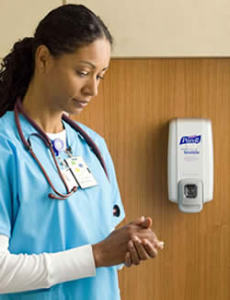 In 1981 Albert and Condie observed that hand washing rates in an intensive-care unit varied between 30-48% (New England Journal of Medicine, 304, 1465-1466, 1981). Apparently, hand washing doesn’t come any naturally to modern physicians than it did their 19th century forebears.
In 1981 Albert and Condie observed that hand washing rates in an intensive-care unit varied between 30-48% (New England Journal of Medicine, 304, 1465-1466, 1981). Apparently, hand washing doesn’t come any naturally to modern physicians than it did their 19th century forebears.
The problem persists. In 1996, Tibbals reported that only 12% of physicians in a pediatric intensive-care unit washed their hands after patient contact (Medical Journal of Australia, 164, 395, 1996). Even after an intensive program of education, monitoring, and feedback, hand washing rates rose only to 17%. When another sample of doctors were surveyed about their behaviour, they reported that they washed their hands from 50-95% of the time; but when they were surreptitiously observed, their actual rate was as low as 9%. Pritchard and Raper, commenting on this study (Medical Journal of Australia, 164, 389-390, 1996), wrote that:
It seems a terrible indictment of doctors that practices and protocols must be developed to take the place of something as simple… as hand washing. Perhaps an even bigger concern for current medical practice, and one which should lead us all to do some soul searching, is that careful and caring doctors can be extraordinarily self-delusional about their behaviour.
John F. Kihlstrom, PhD – Institute for the Study of Healthcare Organizations & Transactions
Only one in four doctors wash their hands between patients on some wards within the McGill University Health Centre, an internal audit has found.By The Gazette (Montreal) January 6, 2009
The problem is clear, but the solution isn’t simple. It has been demonstrated that using technology such as RFID is beginning to address this age long issue and the cause of so much of today’s Hospital Acquired Infections (HAIs). According to the World Health Organization there are key times when healthcare professionals should wash their hands. The WHO has published guidelines called “My 5 Moments for Hand Hygiene” and recommends that healthcare workers to clean their hands:- Before touching a patient
- Before clean/aseptic procedures
- After body-fluid exposure or risk
- After touching a patient
- After touching patient surroundings
